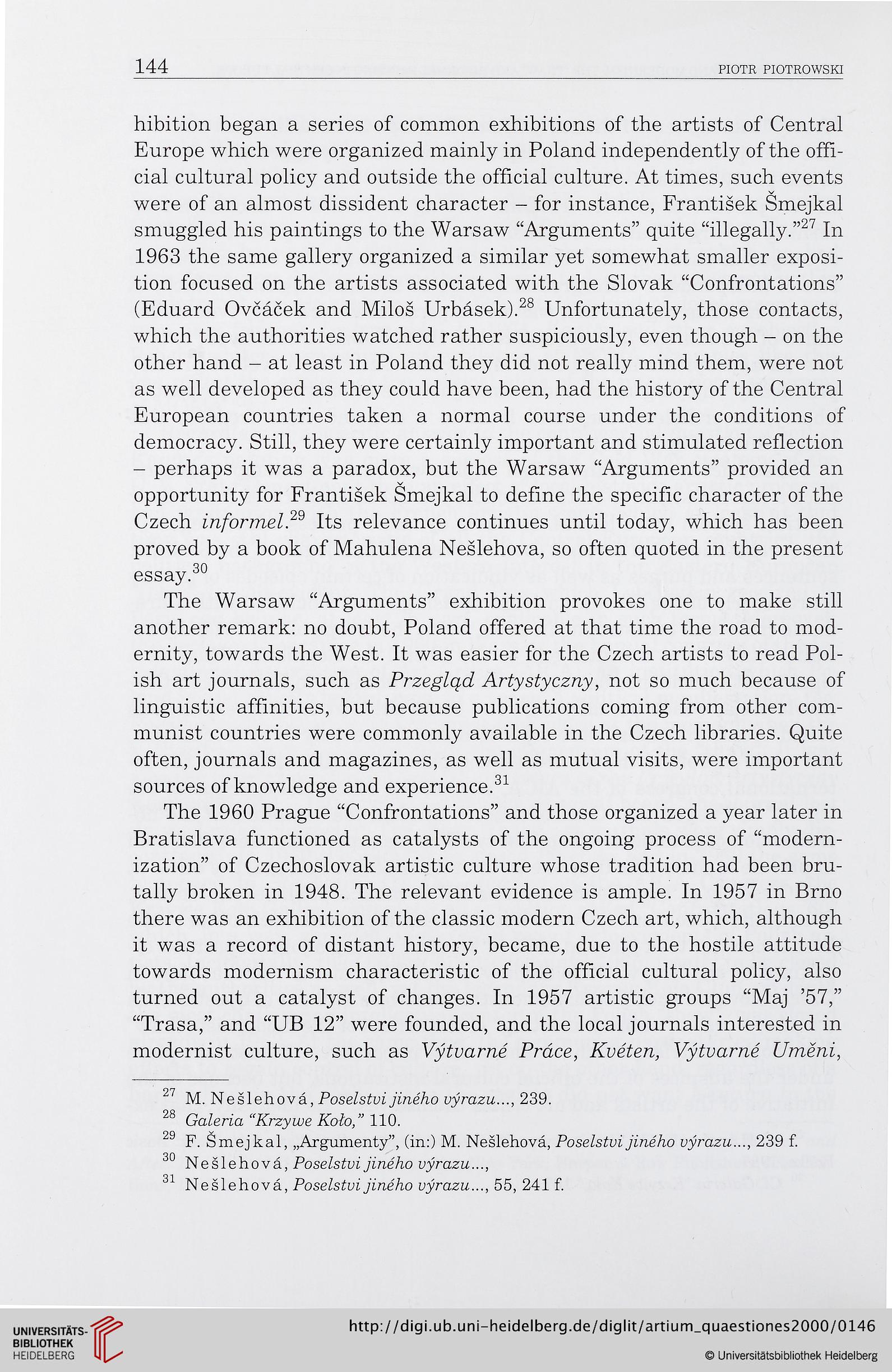144
PIOTR PIOTROWSK3
hibition began a sériés of common exhibitions of the artists of Central
Europe which were organized mainly in Poland independently of the offi-
cial cultural policy and outside the official culture. At times, such events
were of an almost dissident character - for instance, Frantisek Smejkal
smuggled his paintings to the Warsaw “Arguments” quite “illegally.”27 In
1963 the same gallery organized a similar yet somewhat smaller exposi-
tion focused on the artists associated with the Slovak “Confrontations”
(Eduard Ovcâcek and Milos Urbâsek).28 Unfortunately, those contacts,
which the authorities watched rather suspiciously, even though - on the
other hand - at least in Poland they did not really mind them, were not
as well developed as they could hâve been, had the history of the Central
European countries taken a normal course under the conditions of
democracy. Still, they were certainly important and stimulated reflection
- perhaps it was a paradox, but the Warsaw “Arguments” provided an
opportunity for Frantisek Smejkal to define the spécifie character of the
Czech informel.29 30 Its relevance continues until today, which has been
proved by a book of Mahulena Neslehova, so often quoted in the présent
qn
essay.
The Warsaw “Arguments” exhibition provokes one to make still
another remark: no doubt, Poland offered at that time the road to mod-
ernity, towards the West. It was easier for the Czech artists to read Pol-
ish art journals, such as Przeglqd Artystyczny, not so much because of
linguistic affinities, but because publications coming from other com-
munist countries were commonly available in the Czech libraries. Quite
often, journals and magazines, as well as mutual visits, were important
sources of knowledge and expérience.31
The 1960 Prague “Confrontations” and those organized a year later in
Bratislava functioned as catalysts of the ongoing process of “modern-
ization” of Czechoslovak artistic culture whose tradition had been bru-
tally broken in 1948. The relevant evidence is ample. In 1957 in Brno
there was an exhibition of the classic modem Czech art, which, although
it was a record of distant history, became, due to the hostile attitude
towards modernism characteristic of the official cultural policy, also
turned out a catalyst of changes. In 1957 artistic groups “Maj ’57,”
“Trasa,” and “UB 12” were founded, and the local journals interested in
modernist culture, such as Vytvarné Prâce, Kvéten, Vytvarné Umëni,
27 M. Neslehova, Poselstui jiného vyrazu..., 239.
2S Galeria “Krzywe Kolo,” 110.
29 F. âmejkal, ,,Argumenty”, (in:) M. Neslehova, Poselstvi jiného vyrazu..., 239 f.
30 Neslehova, Poselstvi jiného vyrazu...,
31 Neslehova, Poselstvi jiného vyrazu..., 55, 241 f.
PIOTR PIOTROWSK3
hibition began a sériés of common exhibitions of the artists of Central
Europe which were organized mainly in Poland independently of the offi-
cial cultural policy and outside the official culture. At times, such events
were of an almost dissident character - for instance, Frantisek Smejkal
smuggled his paintings to the Warsaw “Arguments” quite “illegally.”27 In
1963 the same gallery organized a similar yet somewhat smaller exposi-
tion focused on the artists associated with the Slovak “Confrontations”
(Eduard Ovcâcek and Milos Urbâsek).28 Unfortunately, those contacts,
which the authorities watched rather suspiciously, even though - on the
other hand - at least in Poland they did not really mind them, were not
as well developed as they could hâve been, had the history of the Central
European countries taken a normal course under the conditions of
democracy. Still, they were certainly important and stimulated reflection
- perhaps it was a paradox, but the Warsaw “Arguments” provided an
opportunity for Frantisek Smejkal to define the spécifie character of the
Czech informel.29 30 Its relevance continues until today, which has been
proved by a book of Mahulena Neslehova, so often quoted in the présent
qn
essay.
The Warsaw “Arguments” exhibition provokes one to make still
another remark: no doubt, Poland offered at that time the road to mod-
ernity, towards the West. It was easier for the Czech artists to read Pol-
ish art journals, such as Przeglqd Artystyczny, not so much because of
linguistic affinities, but because publications coming from other com-
munist countries were commonly available in the Czech libraries. Quite
often, journals and magazines, as well as mutual visits, were important
sources of knowledge and expérience.31
The 1960 Prague “Confrontations” and those organized a year later in
Bratislava functioned as catalysts of the ongoing process of “modern-
ization” of Czechoslovak artistic culture whose tradition had been bru-
tally broken in 1948. The relevant evidence is ample. In 1957 in Brno
there was an exhibition of the classic modem Czech art, which, although
it was a record of distant history, became, due to the hostile attitude
towards modernism characteristic of the official cultural policy, also
turned out a catalyst of changes. In 1957 artistic groups “Maj ’57,”
“Trasa,” and “UB 12” were founded, and the local journals interested in
modernist culture, such as Vytvarné Prâce, Kvéten, Vytvarné Umëni,
27 M. Neslehova, Poselstui jiného vyrazu..., 239.
2S Galeria “Krzywe Kolo,” 110.
29 F. âmejkal, ,,Argumenty”, (in:) M. Neslehova, Poselstvi jiného vyrazu..., 239 f.
30 Neslehova, Poselstvi jiného vyrazu...,
31 Neslehova, Poselstvi jiného vyrazu..., 55, 241 f.





